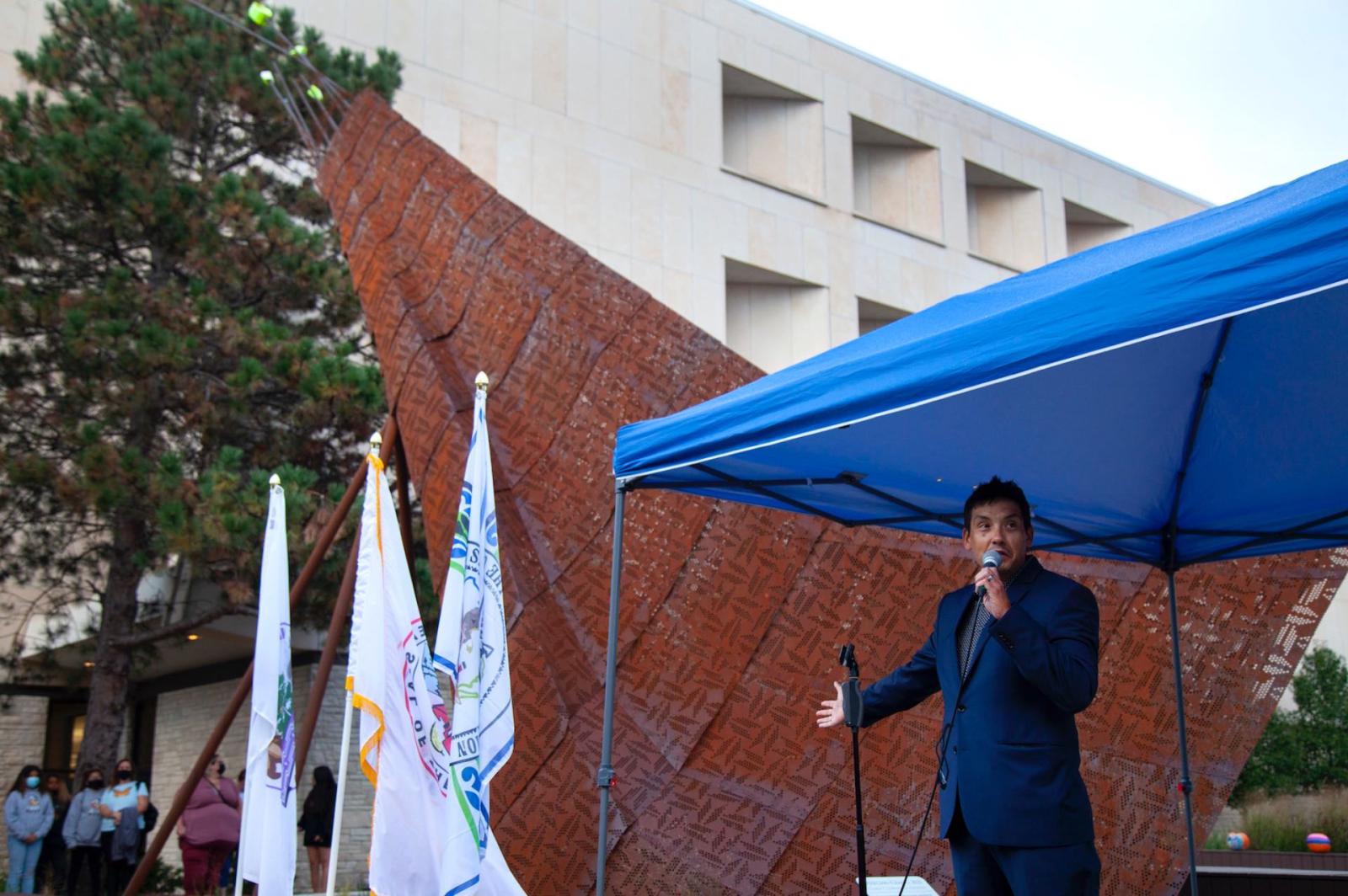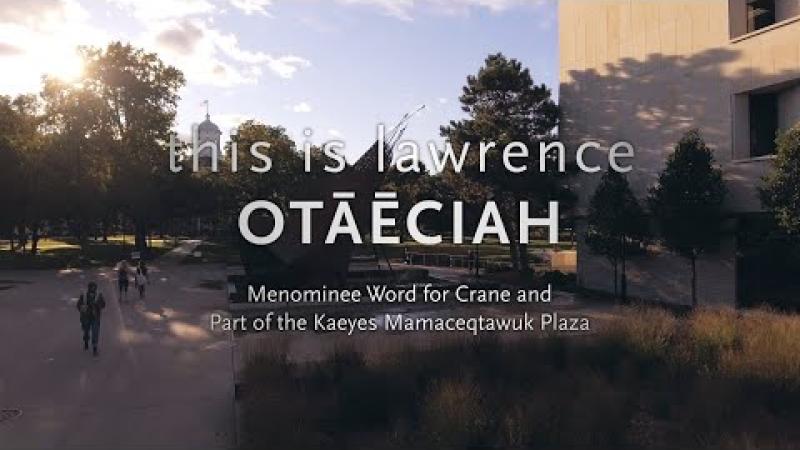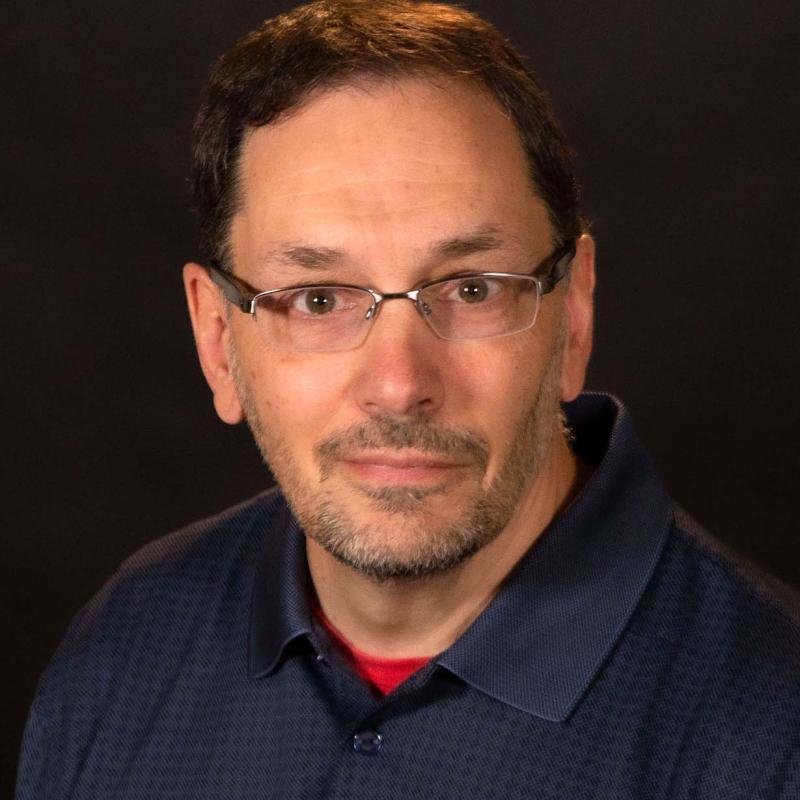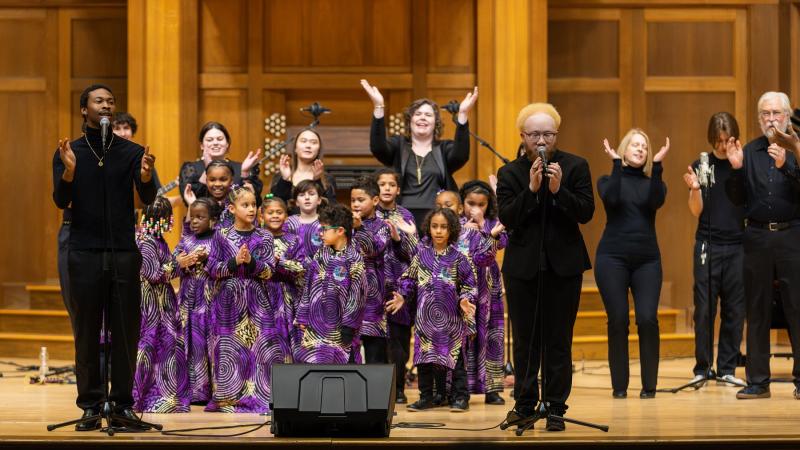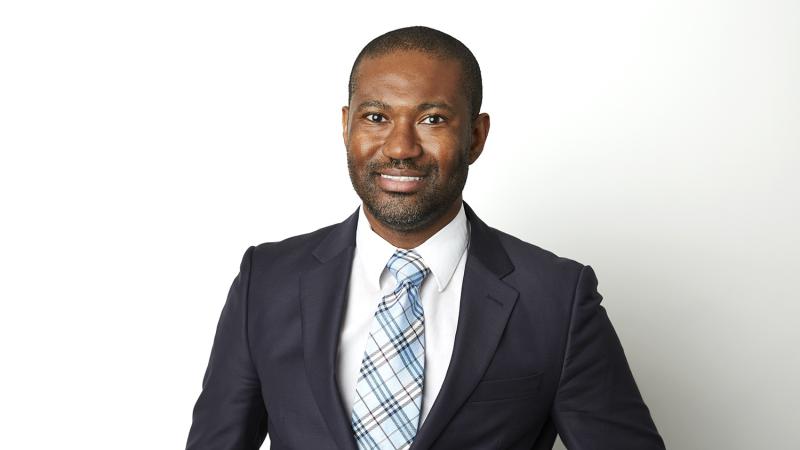Chris Cornelius looks at the contemporary art sculpture that has become the centerpiece of the plaza outside Lawrence University’s Mudd Library, its shape pointing purposely northwest toward what is now the home of the Menominee Nation, and wonders what conversations it might spark.
“I would hope the Indigenous community here on campus would see it as a place to gather, to have as a physical symbol that they are being acknowledged, and to open those conversations up about how land was acquired and who was Indigenous to it and how do we begin to reconcile that with one another,” said Cornelius, the architect who created Otāēciah, the public sculpture now on permanent display on the renamed Kaeyes Mamaceqtawuk Plaza.
A member of the Oneida Nation of Wisconsin and newly named chair of the Department of Architecture at the University of New Mexico, Cornelius joined with current LUNA (Lawrence University Native Americans) students, members of local tribal communities, families from the Appleton Area School District, and the Lawrence campus on Monday evening for a dedication of the sculpture and the renamed plaza.
Otaeciah | This is Lawrence
Chris T Cornelius (Oneida), Principal Founder of Studio:Indigenous, collaborates with Lawrence students, faculty and staff to install a permanent structure on Lawrence's Kaeyes Mamaceqtawuk Plaza.
It was the culmination of more than two years of work.
Installed in late summer, the sculpture is intended to be a permanent piece that further acknowledges and honors the Menominee and Ho-Chunk people, who are Indigenous to the land where Lawrence is situated. The dedication comes on Indigenous Peoples’ Day, a day that a growing number of cities, states, K-12 school districts, and universities have declared a holiday.
The sculpture was funded by a gift from Robert ’64 and Patricia Anker.
The Boldt Co. provided welding and structural work during the installation, working in partnership with Cornelius as the Otāēciah sculpture took shape. It follows the 2019 installation of the temporary Project 562 mural on the outside wall of the Buchanan Kiewit Wellness Center, which also aimed to amplify the perspectives of Native American voices at Lawrence.
President Laurie A. Carter told visitors to Monday’s dedication that the sculpture is a visual reminder that Lawrence is and will be a welcoming place for all.
“Today is more than a dedication,” Carter said. “Today is also Indigenous Peoples’ Day, on which we both honor our local Indigenous communities, including the Menominee and Ho-Chunk Nations and the surrounding Oneida and Mohican people, and envision a future that prioritizes new ways of making Indigeneity visible on our campus. There is a reason why we stand here between Seeley G. Mudd Library and the Wriston Art Galleries. This plaza is located at one of the busiest crossroads of our campus and is clearly visible from College Avenue, one of Appleton’s most important and traversed thoroughfares. You can’t drive by or walk across the center of campus without passing this plaza or seeing this sculpture. Today we make visible Lawrence’s Native American students, faculty, and staff, whose perspectives have historically not been visible enough here on our campus.”
Former Lawrence President Mark Burstein was an early advocate for the Otāēciah sculpture project. He reached out to the Ankers, avid supporters of Native artists, and found willing partners in making the project happen. The Ankers traveled from Carmel, Indiana, to attend Monday’s dedication.
“As we accumulated art over the decades, we became focused on Native art and artists,” Robert Anker said. “Pat chaired the Indian Market and Festival of the Eiteljorg Museum of American Indians and Western Art (in Indianapolis) for many years and continues to serve as a member of the museum’s board of directors. Through the years we have built deep and continuing friendships with many Native artists. Mark became aware of these facts simply because he is Mark, thus making both the ask and the answer easy.”
“Our voices aren’t often centered in that way”
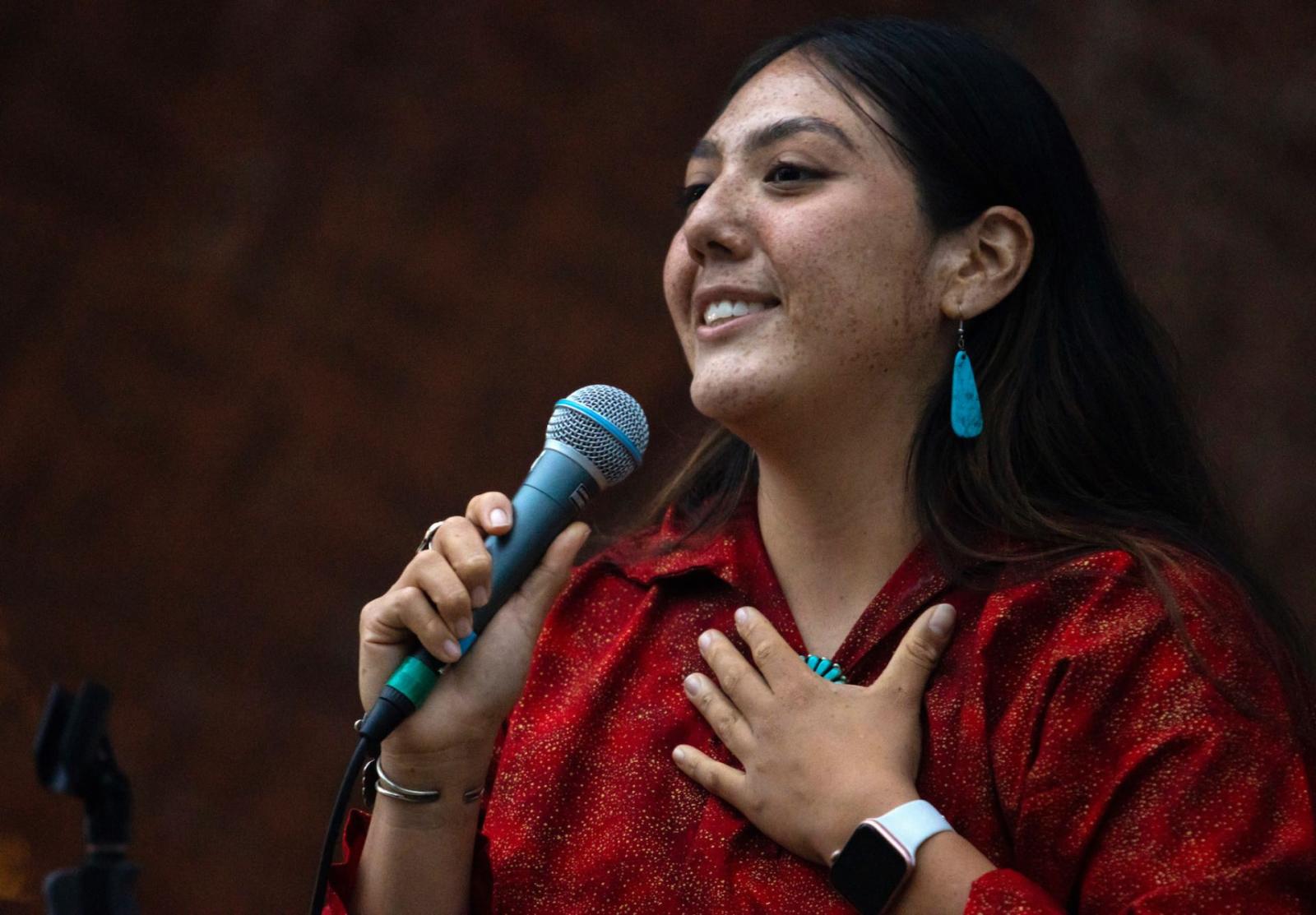
Lawrence student Taneya Garcia, president of LUNA, tells the crowd gathered for the Indigenous Peoples’ Day Celebration that the Otāēciah sculpture and all it represents “warms my heart.” (Photo by Danny Damiani)
Lawrence connected with Cornelius at the suggestion of Beth Zinsli ’02, assistant professor of art history and curator of the Wriston Art Center Galleries. She had seen Cornelius’ work at a 2018 art show at Marquette University’s Haggerty Museum of Art.
“His piece in that show just bowled me over,” she said. “I started looking into his work a bit more and learned that he is an acclaimed architect and that he grew up closer to campus, in Oneida. … I was really committed to working with him in some way.”
Much of Cornelius’ work has focused on the architectural translation of culture; in particular, American Indian culture. He is the founding principal of studio:indigenous, a design and consulting firm serving American Indian clients. He holds a master of architecture degree from the University of Virginia and a bachelor’s degree in architectural studies from UW-Milwaukee.
Once Cornelius was on board, he set out to bring the voices of Native students at Lawrence into the planning for the sculpture. He wanted to hear about their experiences and sought their insights as he began to map out what the piece would look like, what symbols it would include, and what messages it might send.
“It was very important to him that he heard their voices,” said Brigetta Miller ’89, an associate professor of music in the Lawrence Conservatory who has served as the faculty advisor to LUNA, a student organization, since its inception in 2008. “I love that. Our voices aren’t often centered in that way.”
Miller is a member of the Stockbridge-Munsee (Mohican) Nation and is a descendant of the Menominee Nation in Wisconsin.
Taneya Garcia, a senior majoring in both anthropology and ethnic studies, is president of LUNA. A member of the Santa Ana and Acoma Pueblo of New Mexico, she said she has been thrilled to see the amplification of Native voices at Lawrence since she arrived on campus three years ago, starting with the initial adoption of a land acknowledgement in 2018 and followed by the Indiginize Education land project mural and convocation with Project 562 in 2019.
Now the Otāēciah sculpture brings more permanence to that commitment, Garcia said. Native students know their voices were part of its creation, and Native students today and in the future can see themselves represented in the art.
“Once they see themselves, they kind of have that reinforcement that we’re here, and we’re always going to be here,” Garcia said.
“It opens up and you can look at the sky”
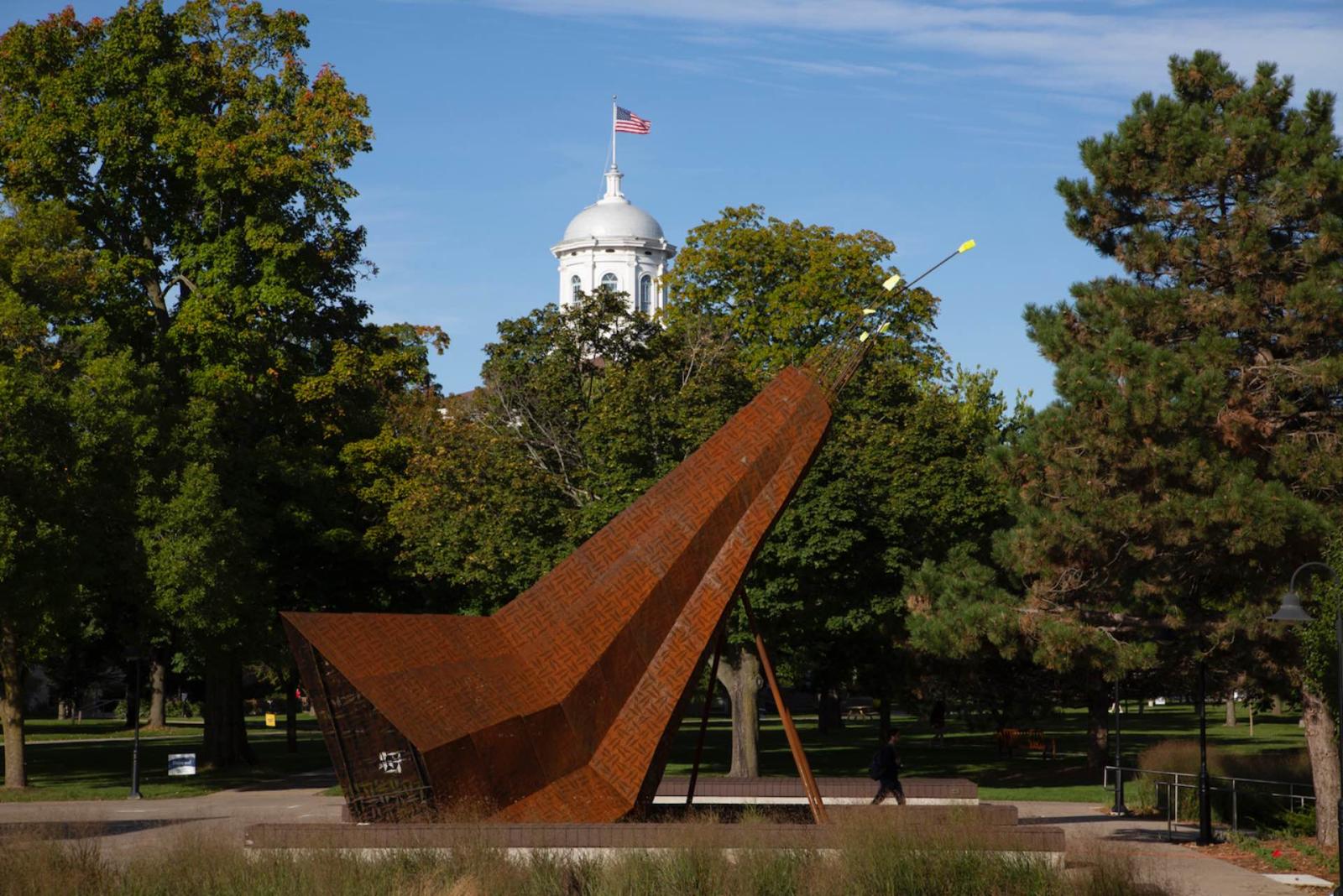
Otāēciah is a contemporary art sculpture now on permanent display on the renamed Kaeyes Mamaceqtawuk Plaza on the Lawrence University campus. (Photo by Liz Boutelle)
Cornelius said the message from the students meshed with his own vision for the project—to pay respect to the Menominee people and their traditions.
The sculpture, made of weathering steel that is intentional in its rust, is not intended to look like anything specific, Cornelius said. But its name, Otāēciah, means “crane” in Menominee. Finding inspiration in animals and nature is reflective of the culture, he said. And the Indigenous patterns that are part of the sculpture speak to the arts and crafts of the Menominee people.
“You will see that the skin of this piece is intended to reflect some of that, some of the original reflections of nature,” Cornelius said.
The rust, Cornelius said, provides a protective coding and will change in tone over time.
Visitors to the sculpture are encouraged to walk inside, admire the design, and look through its openings.
“It opens up and you can look at the sky,” Cornelius said. “You can get in the middle of it, get inside it. It’s not just a sculpture. It’s intended to be a space. And to have that experiential quality to it.”
A Boldt Co. crew spent several weeks in August bringing Cornelius’ vision to life, assembling and welding the intricate pieces.
“A piece like this takes a significant amount of work,” Cornelius said during the installation. “For me as the designer, I have one person on staff. But how it’s being constructed is really being supported by Boldt. They’ve been excellent partners in this endeavor. They are constructing it; we’ve used their structural engineers. They’ve made the process go super smooth.”
The finished product does what public art is supposed to do, Zinsli said. It speaks to place and history, and it invites reflection.
“In his practice overall, Chris has created this distinctive visual language that complicates the boundaries between the natural world and the built environment in ways I find really exciting,” Zinsli said. “In Otāēciah, Chris deftly integrated Menominee symbols to create this powerful, visually arresting work of public art. I particularly love the way the sculpture invites somewhat playful interactions—you can walk inside it—while also persistently reminding us on whose ancestral lands our campus has been built, through its iconography and purposeful orientation toward the present land of the Menominee Nation. This is precisely what good public art can do—become an integral and beautiful part of the campus landscape while also embodying the values our community holds in common.”
“I think it’s important to start that conversation”
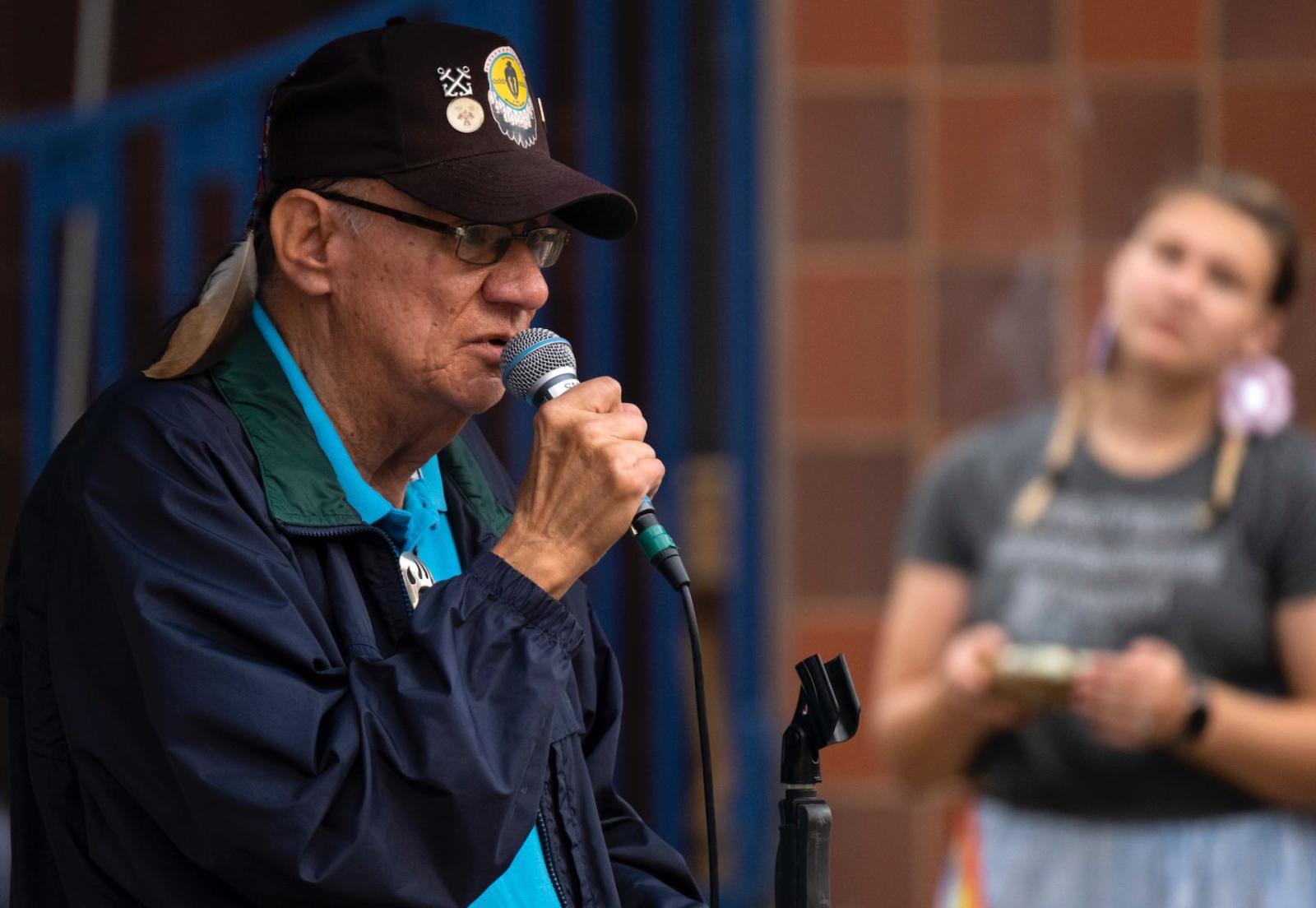
Dennis Kenote, a Menominee elder, applauded Lawrence for its celebration of Indigenous Peoples’ Day and its commitment to its land acknowledgement. (Photo by Danny Damiani)
Monday’s dedication was one more chapter in what hopefully will be an ongoing conversation about indigeneity, Cornelius said. He applauded Lawrence—its history dates back 174 years, predating Wisconsin becoming a state—for its willingness to engage in such discussions and reflection.
“It’s important to understand the relationship that Indigenous people had originally to the land, for us to be able to have conversations about how we ended up where we are,” Cornelius said. “How did we end up where Lawrence University is here on what was Menominee land? I think it’s important to start that conversation, and for me it’s doing that through this piece. Through art and sculpture, we can begin to have those kinds of conversations about the university and the founding of the university. Lawrence was here before Wisconsin even became a state. But we should have conversations about who was here before it was even known as Wisconsin, before European contact. That’s the thing the piece itself is intended to do, to help spark those conversations.”
For Miller, these conversations are essential. She’s hopeful the sculpture and the Kaeyes Mamaceqtawuk Plaza, located in a busy cross-section of campus that draws much foot traffic, will spur the sort of “deep interdisciplinary reflection that’s necessary in order to understand the interconnectedness of Indigenous ways of knowing.”
Dennis Kenote, a Menominee Nation elder, recorded pronunciations of Kaeyes Mamaceqtawuk and Otāēciah. He shared his knowledge of Menominee history and customs at Monday’s dedication.
Miller said she hopes Lawrentians will actively practice the proper pronunciation and begin referring to both the sculpture and the plaza by their Menominee names.
“Our Native relatives have always placed high value on learning through the oral tradition,” Miller said. “The challenge of correctly pronouncing the word is good for our campus—it shatters stereotypes and shows the complexity and higher-level thinking required in our Indigenous languages.”
Monday’s celebration, which drew several hundred people, featured a pow wow demonstration by Str8 Across, an Oneida drum and dance group. Norbert Hill, an Oneida elder, told those gathered that this celebration needs to last beyond this one day.
“This monument reminds people that Indigenous Peoples’ Day is every day,” he said.
Miller called the permanence of the installation significant, saying it marks an important step in the continuation of Lawrence’s land acknowledgement.
“This is not something that’s just going to go away,” Miller said. “As Native people, we want to make it clear that we’re alive. We are here. We are present.”
Signage on Kaeyes Mamaceqtawuk Plaza
Otāēciah (Crane), Chris T. Cornelius (Oneida)
The form of Otāēciah references a crane, one of the five traditional Menominee clan symbols. The perforated and patinaed steel panels, modeled after woodland textile patterns, overlap like a bird’s feathers. Menominee beadwork designs, created with elements of geometric patterns, are prominently featured. The decorative shapes that crown the piece signify ceremonial regalia. The sculpture points directionally toward the present land of the Menominee Nation. The three inside posts supporting the sculpture represent LUNA’s motto: “We stand together – stronger together.”
Otāēciah Pronunciation Guide
Audio assist: Menominee elder Dennis Kenote provides pronunciation for Otāēciah
Menominee Orthography: Otāēciah
International Phonetic Alphabet: ɔtɑːʔt͡ʃijɑʰ
Pronunciation guide: o-TAA-chee-ah
Translation: Crane
Kaeyes Mamaceqtawuk Plaza Pronunciation Guide
Audio guide: Menominee elder Dennis Kenote provides pronunciation for Kaeyes Mamaceqtawuk
Menominee orthography: Kāēyas mamāceqtawak
International Phonetic Alphabet: /kajæs məmɑːʔt͡ʃɪtɑwək /
Pronunciation guide: Ka-YES muh-MAA-chi-TA-wuk
Translation: Ancient people that move
Plaza and Sculpture Word History
Menominee elder Dennis Kenote provides history on the language of the words Otāēciah and Kaeyes Mamaceqtawuk.
